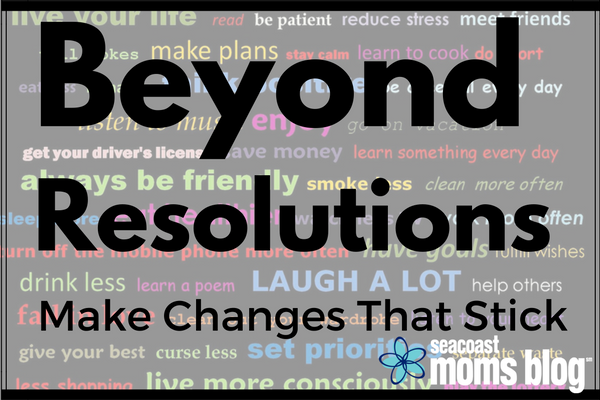In 2017, I have some resolutions. I want to continue to rediscover myself, get healthier and be happier, and do more of what makes me happy.
Yes, I can make resolutions like “exercise more and eat less cake,” “go to church” and “put my phone down when I’m with my kids.” But you and I both know that resolutions usually don’t work. In fact, an article in The Atlantic states that while 40 percent of Americans make resolutions, only 8 percent of those achieve their goals. So how do we make real changes in our lives? How do we make these resolutions more than obligatory, half-hearted, and generic thoughts about what makes a better “me”?
[pinterest count=”horizontal”] 
Another way to look at it is that while, yes, only 8 percent of people who make resolutions will be successful, these folks are still 10 times more likely to achieve their goals than those who don’t bother to make resolutions at all. What we all need is a plan. In an article on the American Psychological Association website, Making Your New Years Resolution Stick, psychologist Lynn Bufka, Ph.D, tells readers,“Remember, it is not the extent of the change that matters, but rather the act of recognizing that lifestyle change is important and working toward it, one step at a time.” So with that, I give you methods for resolution success (from the experts, because let’s face it folks, I need plenty of help myself).
[typography font=”Source Sans Pro” size=”36″ size_format=”px” color=”#7d787d”]The Underlying Problem Method[/typography]
The Atlantic article cites research by Harvard School of Education professors Robert Kegan and Lisa Lahey. These researchers believe that traditional approaches to change don’t work because they don’t address the underlying reasons for the behavior in the first place. In layman’s terms, this means we can’t act differently unless we first look at why we are acting this way in the first place.
There are two types of goals; adaptive and technical.
- A technical goal is something that you develop while an adaptive goal requires you to alter something within in order to be successful.
- A goal can be either adaptive or technical depending on the individual.
- For one person, losing weight is simply a matter of enacting a plan, while for many others is means completely changing their lives.
The article further explains that the problem with the “New Year’s resolution” approach to change is that what you are trying to change is not a behavior problem, but a mindset problem. The Harvard method to change is a simple approach to a complicated issue.
[dropcap]Step 1:[/dropcap] Identify your resolution.
ex: Go on a diet.
[dropcap]Step 2:[/dropcap] Is this an adaptive or technical problem for you?
ex: Have you been successful at dieting in the past?
[dropcap]Step 3:[/dropcap] If adaptive, identify the underlying problem.
ex: I don’t want to deprive myself.
[dropcap]Step 4:[/dropcap] Ask yourself why?
ex: Food brings me comfort and makes me happy.
[dropcap]Step 5:[/dropcap] Address the reasons for the behavior.
ex: Explore healthier ways to find comfort and happiness.
[typography font=”Source Sans Pro” size=”36″ size_format=”px” color=”#7d787d”]The Maximizing Willpower Method[/typography]
Another interesting piece of research linked to New Year’s resolutions was reported by The New York Times in this article: Be It Resolved, in which social psychologist, Roy F. Baumiester, was quoted as saying that willpower is a form of mental energy powered by glucose in the bloodstream, which is used up as you exert self-control. This study concludes that the best way for us all to keep our resolutions is to anticipate the limits of our willpower. By avoiding temptation (resisting temptation depletes willpower, making it less likely you will resist next time) and reinforcing willpower you can consistently increase your chances of resolution success. Methods include:
[dropcap]#1[/dropcap] [typography font=”Source Sans Pro” size=”24″ size_format=”px”]Precommitt[/typography] : Take preventative measures before you face temptation– meal plan, keep junk out of the house, get a workout buddy, go to the store without your credit card.
[dropcap]#2[/dropcap][typography font=”Source Sans Pro” size=”24″ size_format=”px”]Outsource[/typography] : There are a plethora of apps and other technology to help keep your willpower strong.
- StickK.com tracks goals and enforces penalties is you don’t reach them.
- This scale made by Withings will log your weight for you and notify people of the results if you choose.
- The BodyMedia Fit armband and FitBit track your daily activity.
- Mint.com tracks your financial transactions and helps you keep track of where your money is going.
- An app called SmartQuit helps you stop smoking by allowing a person to note his or her thoughts and cravings that lead to destructive behaviors, accept them and, over time, choose not to act on them.
[dropcap]#3[/dropcap] [typography font=”Source Sans Pro” size=”24″ size_format=”px”]Reward[/typography] : Rather than always using your willpower to deny yourself, why not flip the perspective on its head and use it to reward? Quit smoking and use your cigarette money to go on vacation. Lose weight and splurge on new clothes.
[typography font=”Source Sans Pro” size=”36″ size_format=”px” color=”#7d787d”]The Fight-Thru Method[/typography]
Forbes has a helpful article, 7 Habit-Creating Tips to Make Your New Year’s Resolution Successful, which talks about what they call the “fight-thru” moment. This is when you encounter challenges to resolution success. You can either wimp out or fight through. Their tips include:
[typography font=”Source Sans Pro” size=”24″ size_format=”px”]Ritualize[/typography] Create new habits by making your resolution part of the things you do EVERY day. By making your resolution a habit you are much more likely to stick to it.
[typography font=”Source Sans Pro” size=”24″ size_format=”px”]Recognize[/typography] When you get to that place where you’re about to throw the resolution book in the fire. Stop and realize that this is your “fight-thru” moment. Knowing what you’re up against makes it much easier to win.
[typography font=”Source Sans Pro” size=”24″ size_format=”px”]Ask Yourself[/typography] When you hit that fight-thru moment ask yourself, “How will I feel if I win this fight-thru?” “How will I feel if I lose it?” These questions bring emotion into the process. Emotion promotes action.
[typography font=”Source Sans Pro” size=”24″ size_format=”px”]Look to the Future[/typography] Take 30 seconds and imagine where your resolution will put you in five years.










